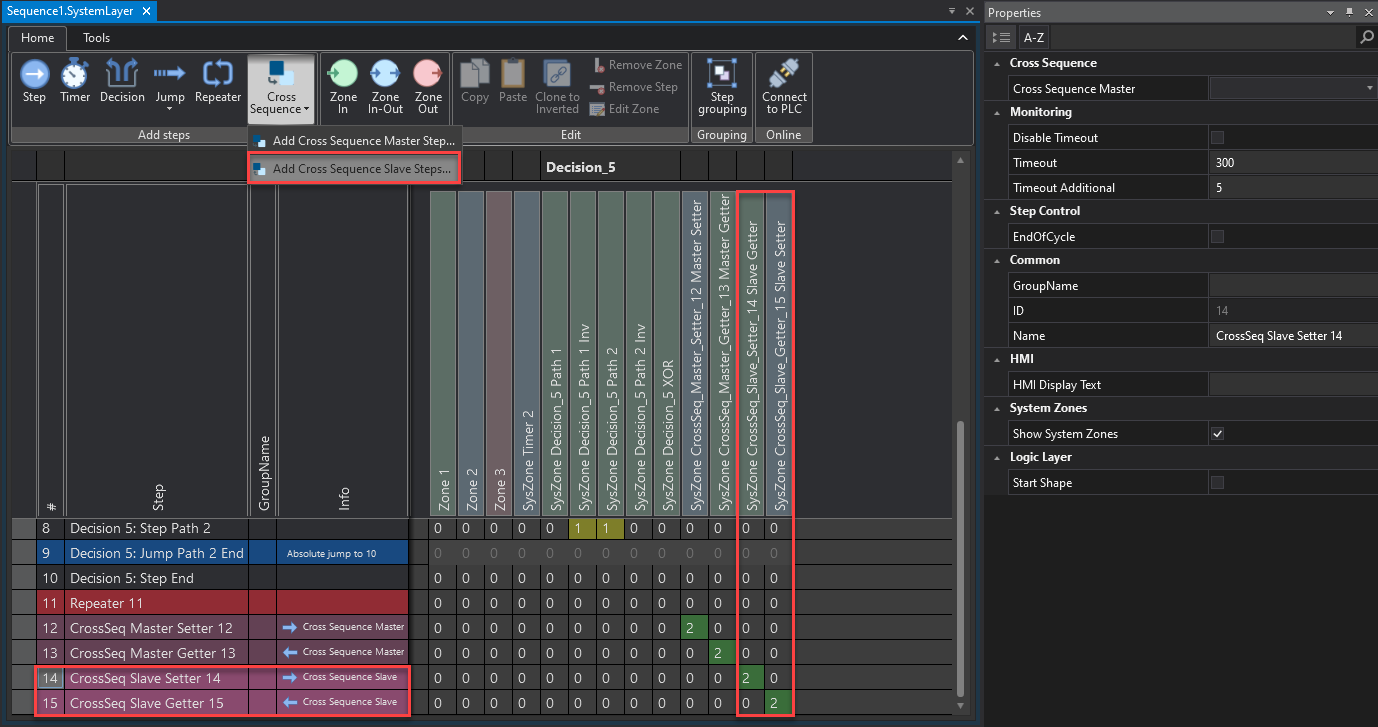In this area the program is modeled, the steps as well as the zones are defined and the machine statuses or monitoring are defined.
The Selmostudio can also be connected to the PLC in order to follow the running program in real time.

Zones

In the zone you describe the state the machine should have in the respective step in order to get to the next step.
Zone In:
A "Zone In" has only an input.
Properties of a Zone In:
•The name of the zone
•A group name, if you want to subordinate several zones to a group
•The HMI display text
•Whether is is a HMI button
•If it is a HMI Button you will have a HMI Button Text
•The input
•The Input Description
•Whether the input is inverted
•How long the controller needs the signal before the signal is passed on
•Declaration as a hardware Input
•The Input Mode: Digital, Analog Value or Analog Parameter
•Whether you need a pair check
•Choose the pair check group
•You see the lamp number and the lamp pair number
•Whether it is a system zone
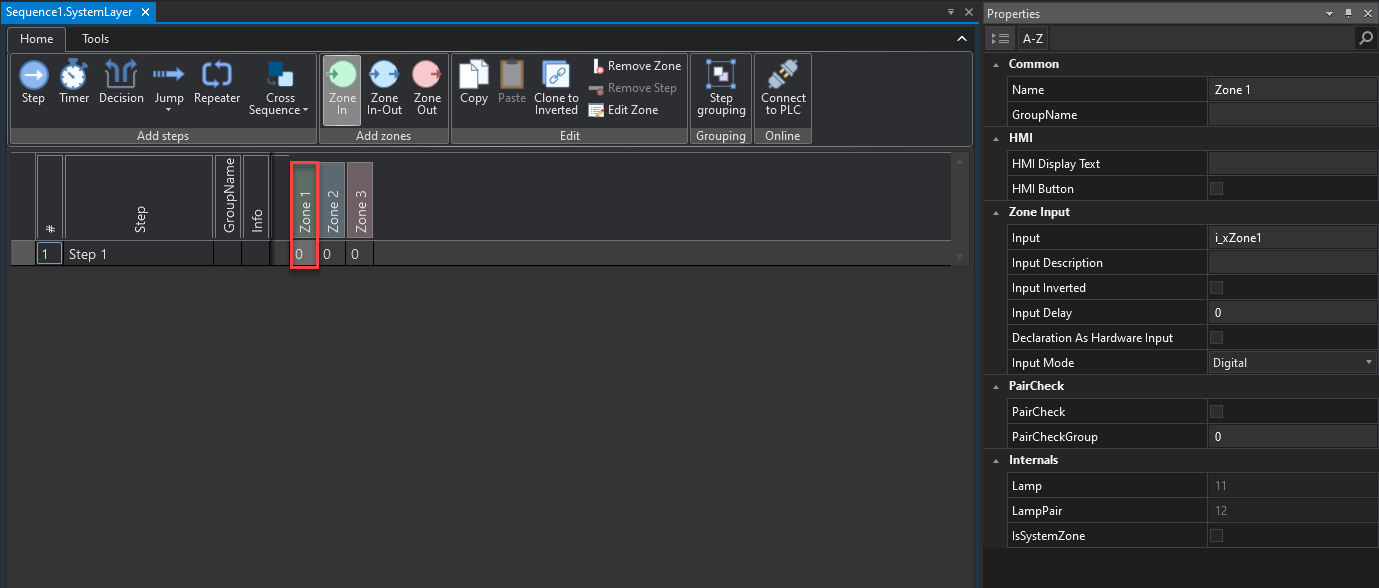
Zone In-Out
A "Zone In-Out" has an input and an output.
Properties of a Zone In-Out:
•The same properties as an "In Zone" including an output
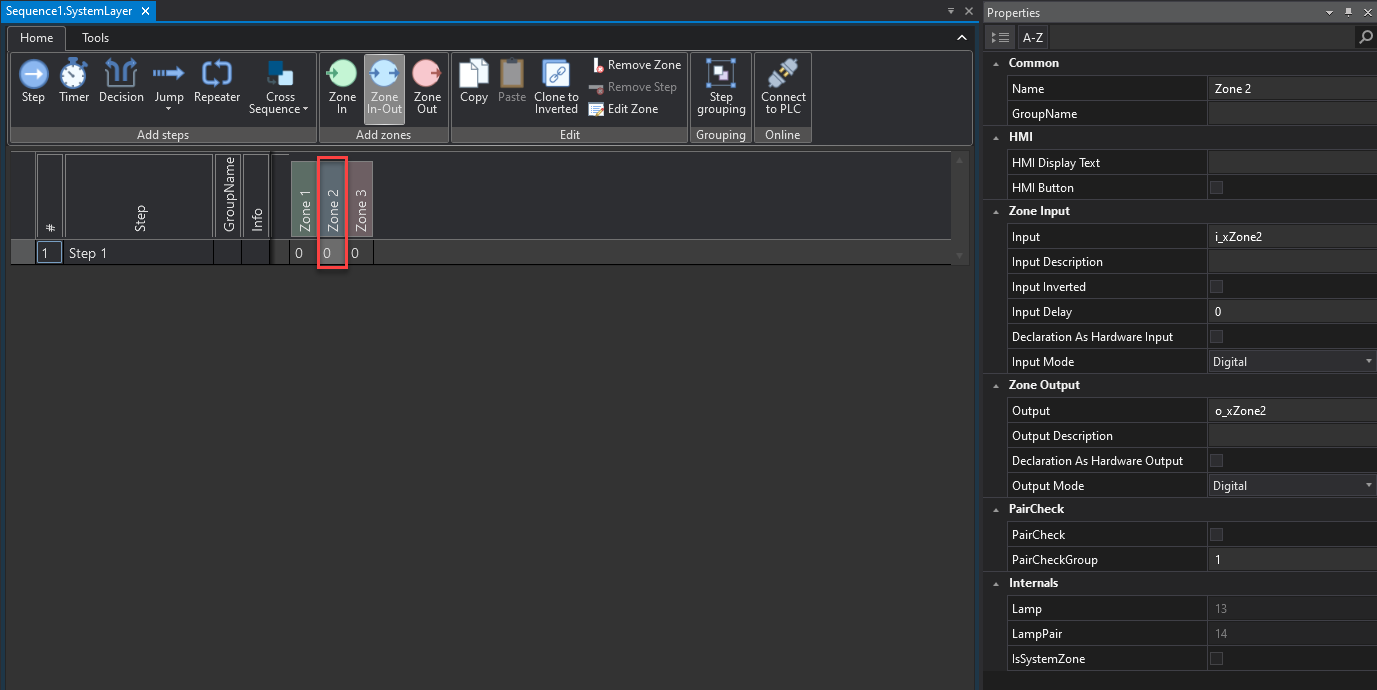
Zone Out
A "Zone Out" has only an output.
Properties of a Zone Out:
•The same properties as an "In Zone" with only an output
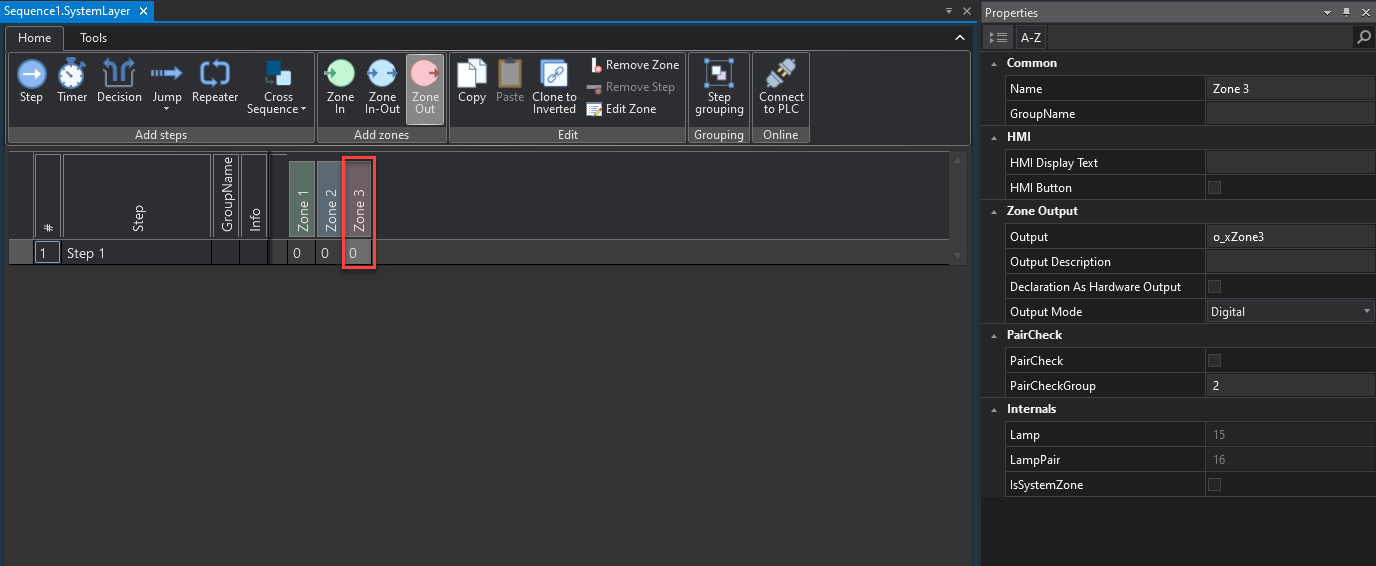
Steps

Step:
A "Step" is a simple step in the sequence
Properties of a step:
•Whether a Timeout is needed or not
•The time (in milliseconds) after which the timeout is activated
•The time tolerance that is appended to the timeout
•Whether it is the end of a cycle
•A group name, if you want to subordinate several steps to a group
•The position of the step in your sequence (ID)
•The name of the step
•A HMI Display Text, if you want one
•Whether this step is the starting step.

Timer
With the timer you set a waiting time between the individual steps.
A timer step automatically includes a special system zone.
Properties of a Timer:
•Whether it is the end of a cycle
•A group name, if you want to subordinate several steps to a group
•The position of the step in your sequence (ID)
•The name of the step
•A HMI Display Text, if you want one
•You see the step type
•You can hide the system zone
•If it is the Start Shape
•Set the Timer Value
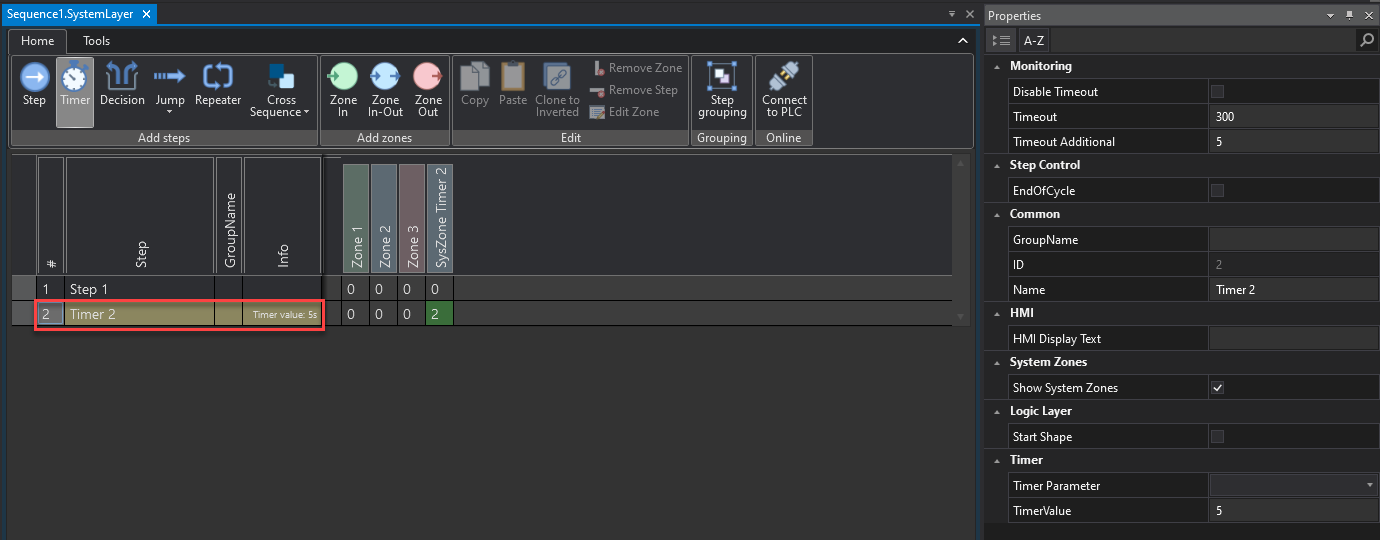
Timer System Zone
A "Timer Zone" is a "In-Out Zone" with special functions for a time delay.
In addition, a "2" is automatically set. (Signal change is expected.)

Absolute Jump
For example, if you want to jump to a certain step, you have to use the "Absolute Jump"
Properties of a Jump:
•Whether a Timeout is needed or not
•The time (in milliseconds) after which the timeout is activated
•The time tolerance that is appended to the timeout
•Whether it is the end of a cycle
•A group name, if you want to subordinate several steps to a group
•The position of the step in your sequence (ID)
•The name of the step
•A HMI Display Text, if you want one
•Choose the step in which the system should jump
•Whether this step is the starting step.
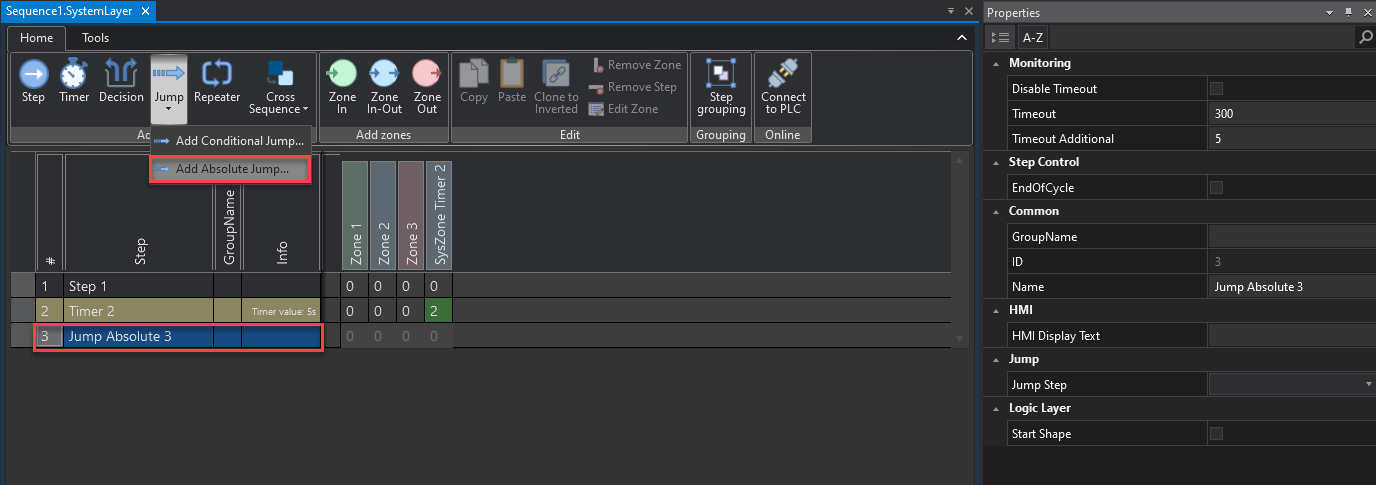
Conditional Jump
For example, if you want to jump to a certain step when a certain value is reached, you have to use the "Conditional Jump"
Properties of a Jump:
•Conditional Jump Variable
•Whether the jump variable is inverted
•Choose the step in which the system should jump
•Whether a Timeout is needed or not
•The time (in milliseconds) after which the timeout is activated
•The time tolerance that is appended to the timeout
•Whether it is the end of a cycle
•A group name, if you want to subordinate several steps to a group
•The position of the step in your sequence (ID)
•The name of the step
•A HMI Display Text, if you want one
•Whether this step is the starting step.

Decision
A "Decision" decides between 2 paths that should be carried out (e.g. a sorting system with 2 different package sizes).
The Decision step automatically includes 6 steps (Decision step, Step Path 1, a Jump step for path 1, Step Path 2, a Jump step for path 2 and an Step End)
and 5 System Zones In (a XOR zone for the Decision, a zone and a inverted zone for both paths).
The 5 zones are normal "In Zones" and have the same properties.
The 5 other steps are normal "Steps" and "Jump Steps"
Properties of a Desicion:
•Whether a Timeout is needed or not
•The time (in milliseconds) after which the timeout is activated
•The time tolerance that is appended to the timeout
•Whether it is the end of a cycle
•A group name, if you want to subordinate several steps to a group
•The position of the step in your sequence (ID)
•The name of the step
•A HMI Display Text, if you want one
•Choose Path 1
•Choose Path 2
•You can show / hide the system zone
•Whether this step is the starting step.
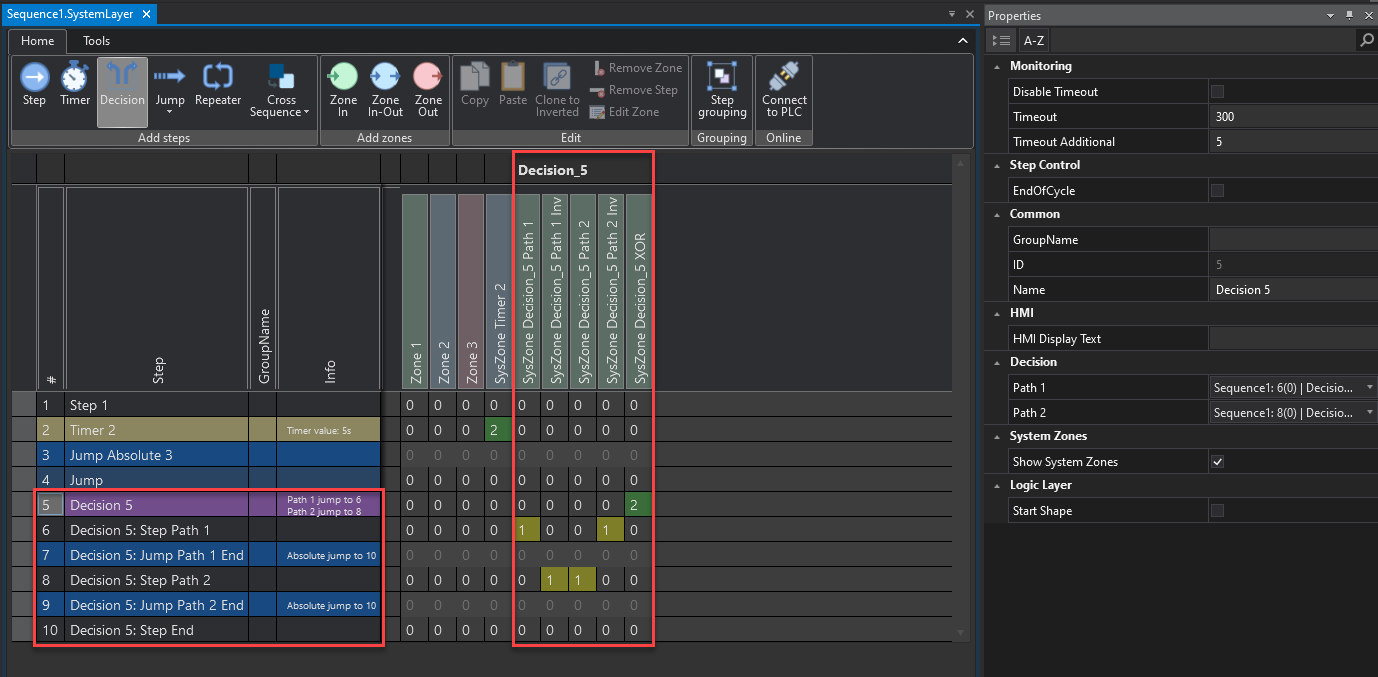
Repeater
A "Repeater" is used if you want to repeat the process as often as you like from any previous step before you get to the next step.
Properties of a Repeater:
•Whether a Timeout is needed or not
•The time (in milliseconds) after which the timeout is activated
•The time tolerance that is appended to the timeout
•Whether it is the end of a cycle
•A group name, if you want to subordinate several steps to a group
•The position of the step in your sequence (ID)
•The name of the step
•A HMI Display Text, if you want one
•Repeater Cancel Variable
•Whether the Repeater Cancel Variable is inverted
•How much iterations you want for the Repeater
•From which step the Repeater should start
•You can show / hide the system zone
•Whether this step is the starting step.

Cross Seq Master
With the "Cross Sequence" you connect 2 sequences with each other and you can monitor them synchronously.
The Cross Seq Master is set in the main program and communicates with the Cross Seq Slave in the subprogram.
It starts the Cross Seq Slave and waits for the ready message.
Properties of a Cross Sequence Master:
•Whether a Timeout is needed or not
•The time (in milliseconds) after which the timeout is activated
•The time tolerance that is appended to the timeout
•Whether it is the end of a cycle
•A group name, if you want to subordinate several steps to a group
•The position of the step in your sequence (ID)
•The name of the step
•A HMI Display Text, if you want one
•You can show / hide the system zone
•Whether this step is the starting step.
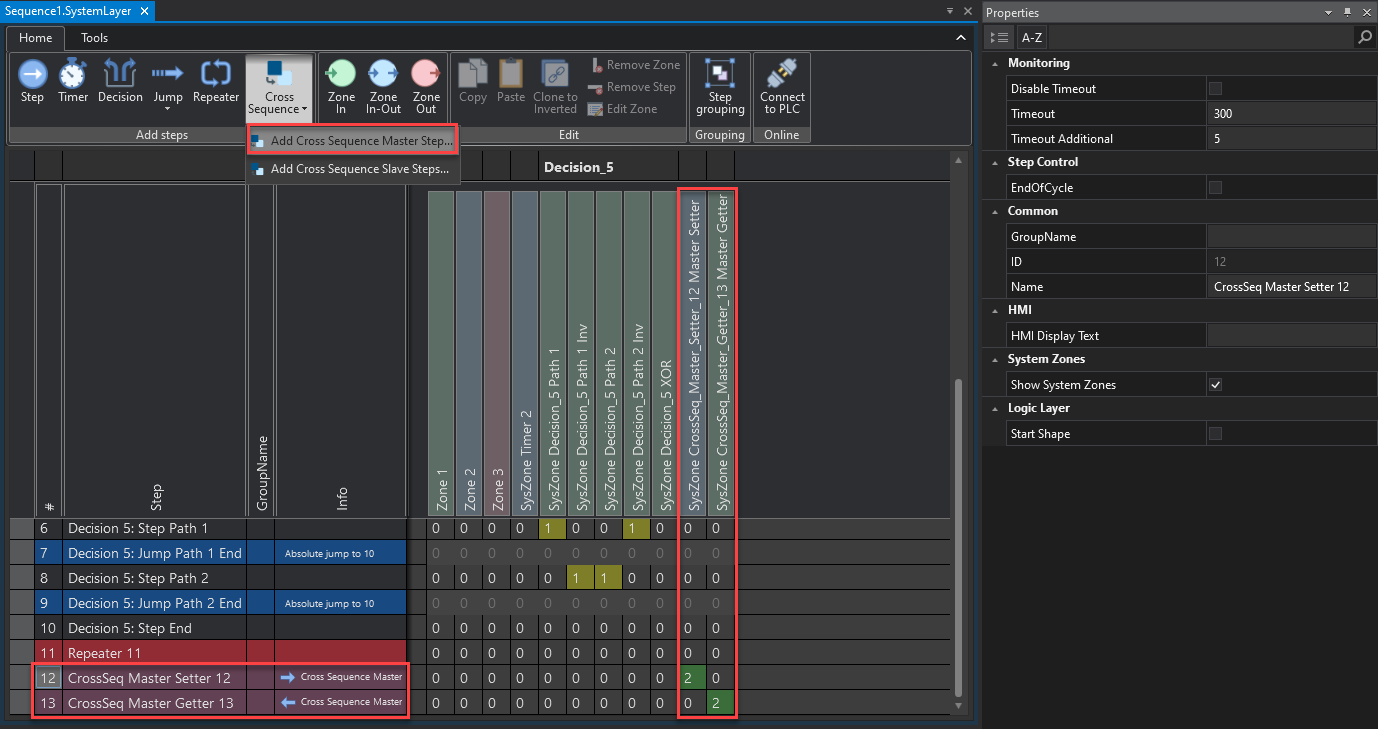
Cross Seq Slave
The Cross Seq Slave is set in the subprogram and communicates with the Cross Seq Master in the main program.
It starts when the Cross Seq Master gives the signal and sends a signal for finished to the Cross Seq Master when finished.
Properties of a Cross Sequence Slave:
•Whether a Timeout is needed or not
•The time (in milliseconds) after which the timeout is activated
•The time tolerance that is appended to the timeout
•Whether it is the end of a cycle
•A group name, if you want to subordinate several steps to a group
•The position of the step in your sequence (ID)
•The name of the step
•A HMI Display Text, if you want one
•You can show / hide the system zone
•Whether this step is the starting step.
